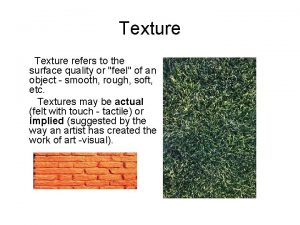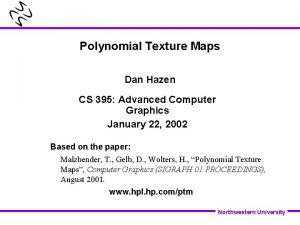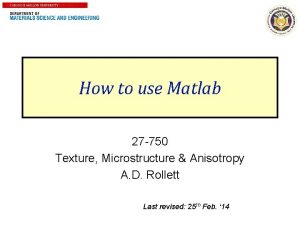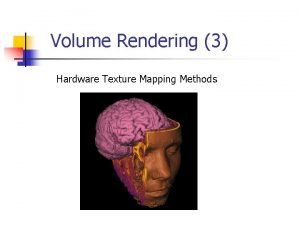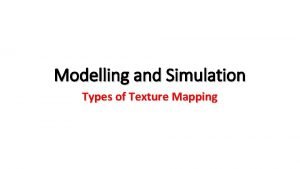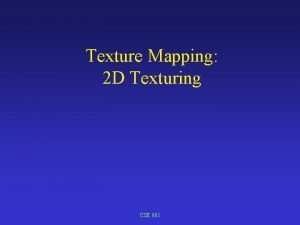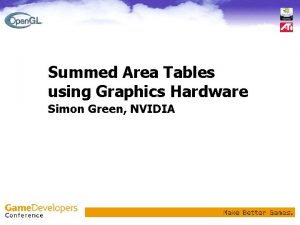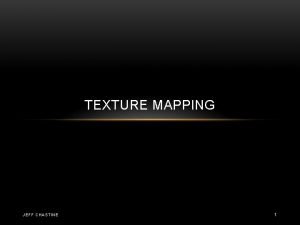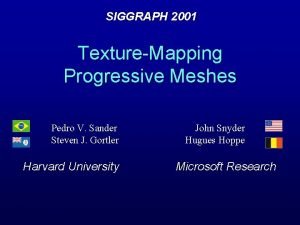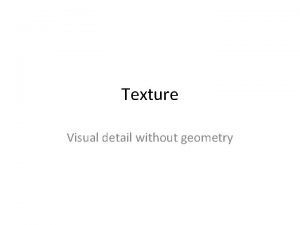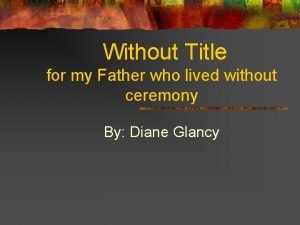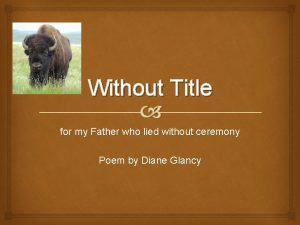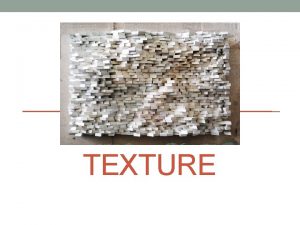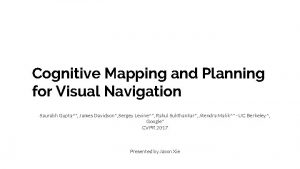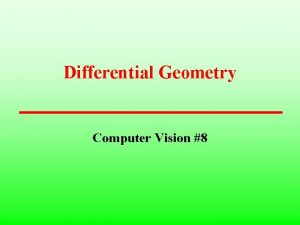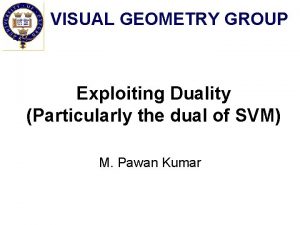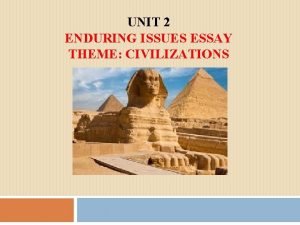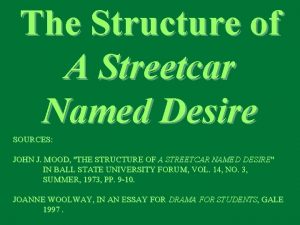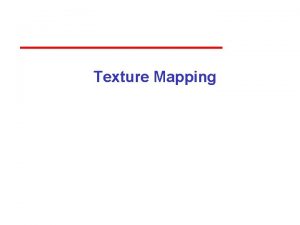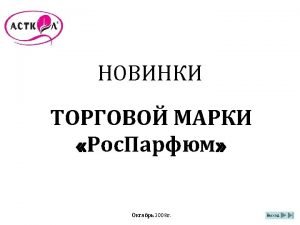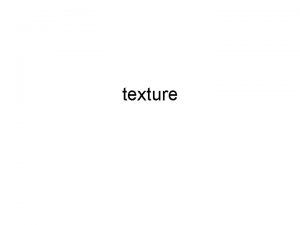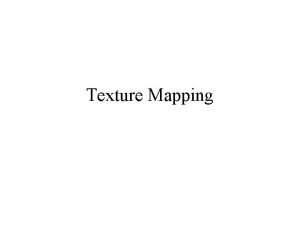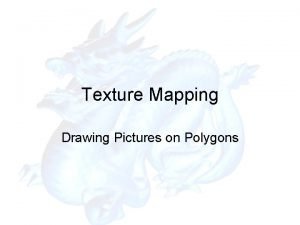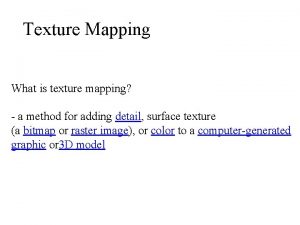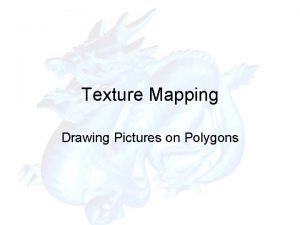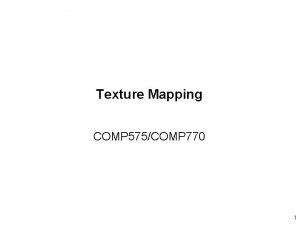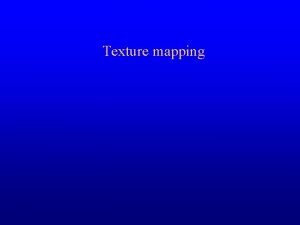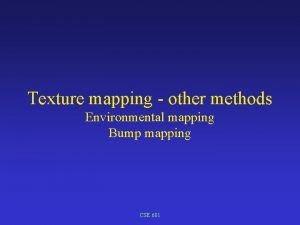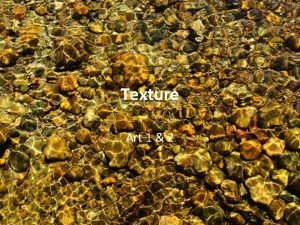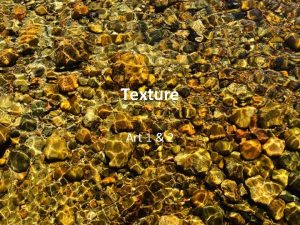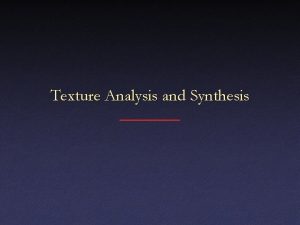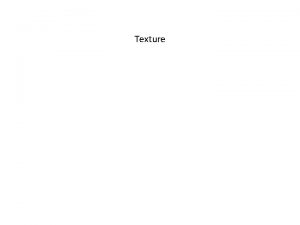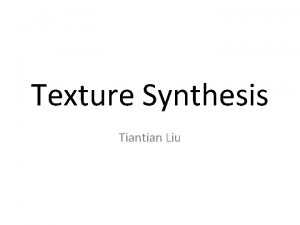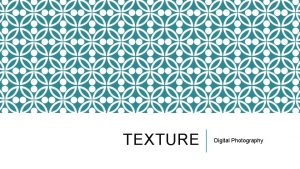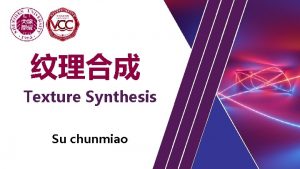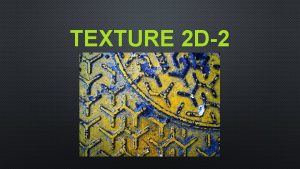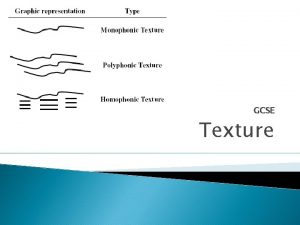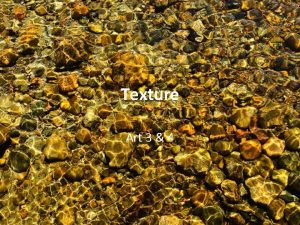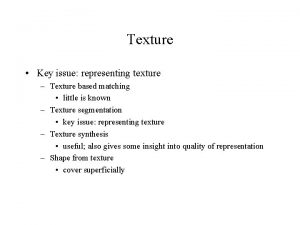Texture Visual detail without geometry Texture Mapping desire



























![MIP mapping • "multum in parvo", "many [things] in a small place" • Store MIP mapping • "multum in parvo", "many [things] in a small place" • Store](https://slidetodoc.com/presentation_image_h/caf75bf5813147009d4fbe11989f7348/image-28.jpg)

- Slides: 29

Texture Visual detail without geometry

Texture Mapping • desire for heightened realism

Texture Mapping • Means of adding visual detail to a scene without adding geometric detail • For each point on the surface, there is a corresponding point in a texture image: fetch surface characteristics from the texture • Characteristics can be color, lighting parameters, surface normal, displacement



Texture Definitions • Regular speech: conventional definition – visual and tactile properties of a surface • Graphics: operational definition – any image used in texture mapping • Vision: mathematical definition – a signal with the property of 'stationarity' (any part is like another part)

Stationarity

Stationarity

Stationarity


Texture Mapping • Cover a surface with an image • Each point has a texture coordinate (u, v) • Typically, the texture coordinates are given at vertices and interpolated like other parameters

Texture Mapping • Simplest object: cylinder (sides only) – u coordinate is angle (normalized to 0. . 1) – v coordinate is height (normalized ditto) • "label on a can of soup" • Not all shapes can be parameterized so easily

Texture Mapping • Map a 2 D surface (in 3 D) to a plane • On the one hand – no problem! The plane is big enough • On the other hand -- we want to satisfy constraints: – no distortion of areas – no distortion of angles – no seams • Impossible!



Solutions • Remove one or more of the constraints: – Allow angles to be distorted – Allow areas to be distorted – Allow seams • Change the problem – Make a mapping from a surface to a surface – Make a mapping from a volume to a surface

Relaxing Constraints • Usual solution – just put up with distortion • A little bit of distortion is not too visible • Allow distortion, but use it: the planar texture is pre-distorted

Relaxing Constraints • Permit seams • Instead of a single "chart", we have a whole "atlas" – the surface is locally flat, so this can work • Need to hide the seams – easy if texture has lots of high-frequency detail – align seams with model features (e. g. , hairline) – put seams in rarely-seen locations

Solid Texture • Instead of a 2 D plane, use a 3 D volume of texture • Mapping is trivial • Object appears to be carved from textured material • Drawback: way more texture needed

Solid Texture

Traditional Texture Mapping • Specify (u, v) coordinates for vertices • (u, v) in ({0, 1}, {0, 1}) – canonical values • Need to specify various characteristics of using the texture – what to do with coordinates outside range – how to combine texture and lighting – mip mapping

Boundary Conditions • One-dimensional texture for simplicity • What does T(1. 1) evaluate to? • Three options: – clamp: T(t) = T(1), t>1 – mirror: T(t) = T(1 -t), 2>t>1 – repeat: T(t) = T(floor(t)) • May introduce visible discontinuities

Combining Texture and Lighting • Texture supplies a color (value in texture map) • Illumination calculation also supplies a color (calculated by local lighting) • Combining them: – use texture only ("decal") – use constant fraction of texture – modulate (multiply values together)

Bump Mapping • Jim Blinn, 1981 • Modify normal direction according to texture • No extra geometry, illusion of high geometric complexity • N = Ninterpolated * (1 -b) + b * Ntexture – and renormalize


Normal Maps • No underlying normal to perturb – entire normal comes from texture • No 3 D geometry needed! Can give illusion of geometry on sprites (just use fake normal in lighting calculation)

Magnification and Minification • Texture rarely appears onscreen at the stored resolution • If it appears smaller: minification filtering • If it appears larger: magnification filtering • Filtering options: – nearest neighbour – linear interpolation – cubic interpolation (smoother, more expensive)
![MIP mapping multum in parvo many things in a small place Store MIP mapping • "multum in parvo", "many [things] in a small place" • Store](https://slidetodoc.com/presentation_image_h/caf75bf5813147009d4fbe11989f7348/image-28.jpg)
MIP mapping • "multum in parvo", "many [things] in a small place" • Store multiple prefiltered scales of texture • Prefiltering done ahead of time, with great care, reducing aliasing and preserving important features • Interpolate between mipmap levels instead of filtering

the Texture. Sampler • In HLSL, reading a value from a texture is done with the Texture. Sampler – auxiliary function defined in shader – specifies what interpolation to use – given coordinates, returns texture value (color) • Shader interprets texture – used for color, normal (bump mapping), position (displacement mapping) , . . .
 It refers to the surface quality or feel of an object
It refers to the surface quality or feel of an object Major details vs minor details
Major details vs minor details Examples of signal words
Examples of signal words Northwestern university
Northwestern university Matlab texture mapping
Matlab texture mapping Texture mapping algorithm
Texture mapping algorithm Texture map types
Texture map types 2d texture mapping
2d texture mapping Summed area table
Summed area table Texture mapping
Texture mapping Texture mapping progressive meshes
Texture mapping progressive meshes The associative mapping is costlier than direct mapping.
The associative mapping is costlier than direct mapping. Forward mapping vs backward mapping
Forward mapping vs backward mapping Terjemahan
Terjemahan Geometry
Geometry Electron geometry and molecular geometry
Electron geometry and molecular geometry 4 electron domains 2 lone pairs
4 electron domains 2 lone pairs Electron geometry vs molecular geometry
Electron geometry vs molecular geometry Without title diane glancy
Without title diane glancy For my father who lived without ceremony
For my father who lived without ceremony Without rush without engines poetic device
Without rush without engines poetic device ____ refers to the tactile qualities of surfaces
____ refers to the tactile qualities of surfaces Cognitive mapping and planning for visual navigation
Cognitive mapping and planning for visual navigation Visual differential geometry
Visual differential geometry Visual geometry group
Visual geometry group Apa yang dimaksud dengan pemrograman konvensional? *
Apa yang dimaksud dengan pemrograman konvensional? * Plissit
Plissit Actiewoorden
Actiewoorden Enduring issues essay introduction
Enduring issues essay introduction Structure of streetcar named desire
Structure of streetcar named desire
